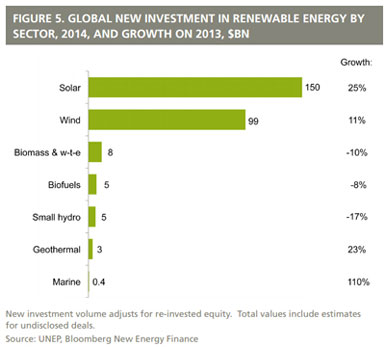2014 was another big year for renewable energy worldwide – for the first time, over 100 gigawatts (GW) were installed in one year.
The 103 GW added – mostly solar and wind – equals the output of all US nuclear plants combined, and is a significant increase from previous years – 86 GW in 2013, 89 GW in 2012 and 81 GW in 2011.
Renewables are edging toward supplying 10% of the world’s power. They contributed 9.1% of all electricity in 2014, up from 8.5% the previous year, and that doesn’t include big hydro.
The industry grew 17% with $270 billion invested, according to the 9th Annual Global Trends in Renewable Energy Investment 2015, by the United Nations Environment Program (UNEP) and Bloomberg New Energy Finance.
Even sharply lower oil prices didn’t stop the growth, thanks to major expansions of solar in China and Japan and record investments in offshore wind.
“Once again in 2014, renewables made up nearly half of the net power capacity added worldwide” says Achim Steiner, UN Under-Secretary-General and Executive Director of UNEP.
“There is now nobody who thinks the energy system of the future will look like the energy system of the past,” says Michael Liebreich, advisory board chair for Bloomberg New Energy Finance.
Solar and wind continue to dominate with 92% of all investments. Solar jumped 25% to $150 billion – its second highest figure ever – and wind rose 11% to a record $99.5 billion. 49 GW of wind and 46 GW of solar PV were added, both records.
Seven $1 billion-plus offshore wind projects were approved in Europe, including the biggest one ever – the $3.8 billion 600 megawatt Gemini project in the Netherlands. Geothermal grew 23% to $2.7 billion invested, but biofuels, biomass and small hydro declined.

China saw record investments of $83.3 billion (up 39% from 2013) and the US came in second at $38.3 billion, up 7% on the year. Japan is third at $35.7 billion, a 10% increase and its biggest year yet.
Read our articles, World Wind Industry Grows 44% in 2014 and Solar Set To Soar Worldwide This Year, 36% Growth!
Read UNEP’s report:
